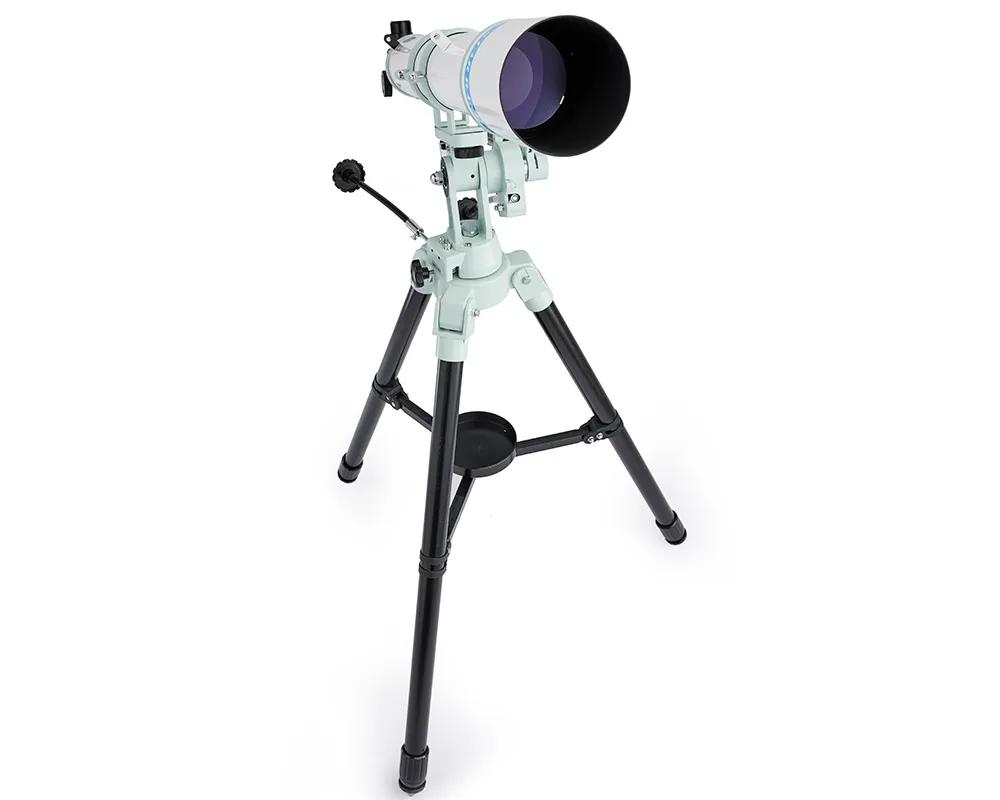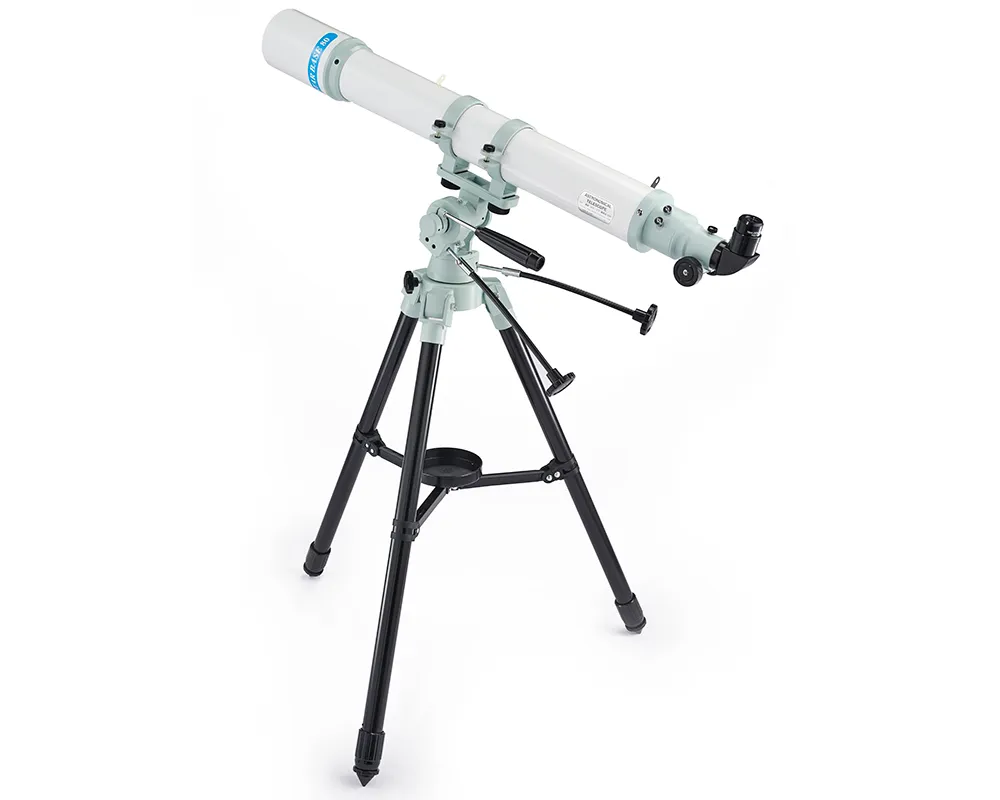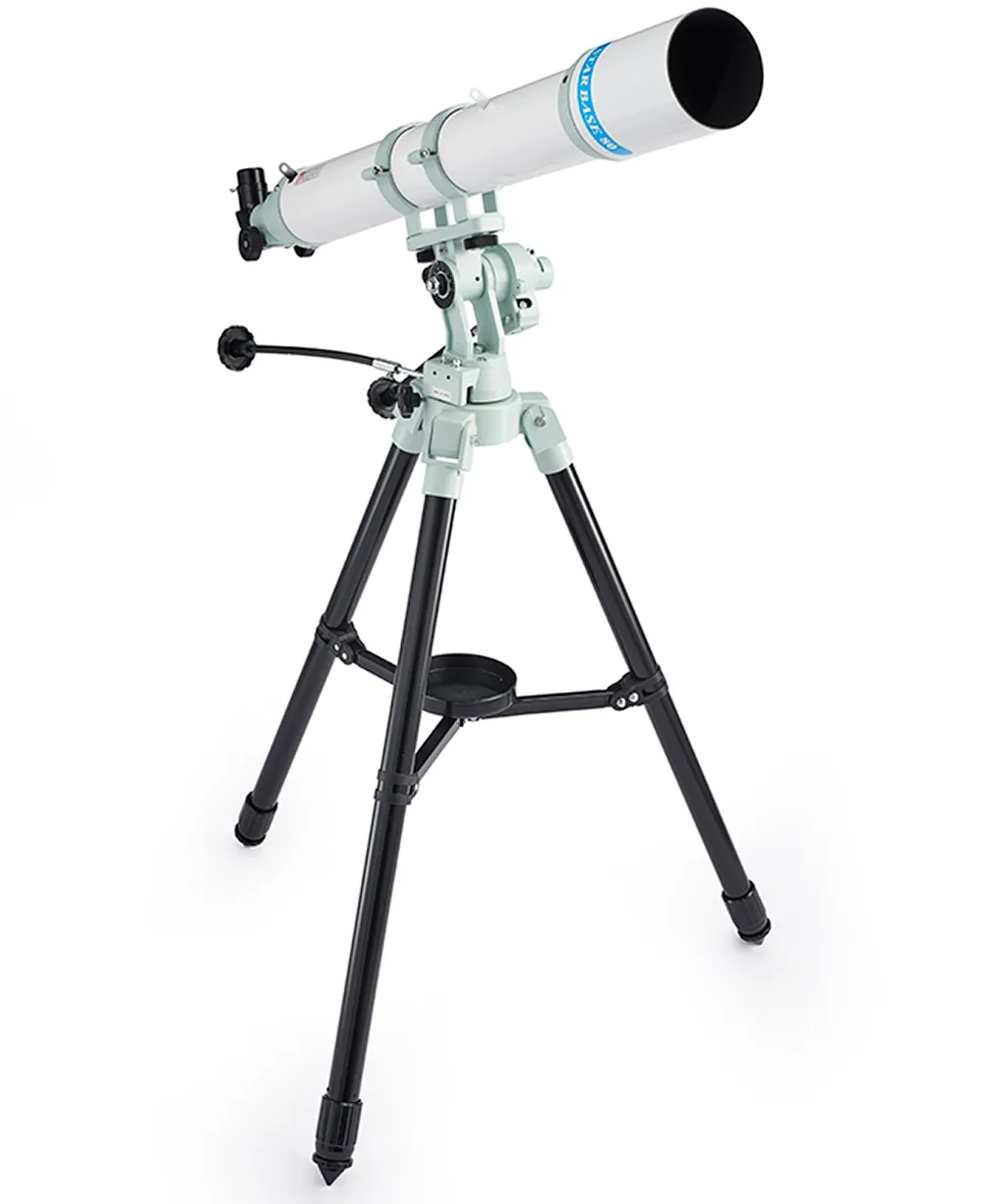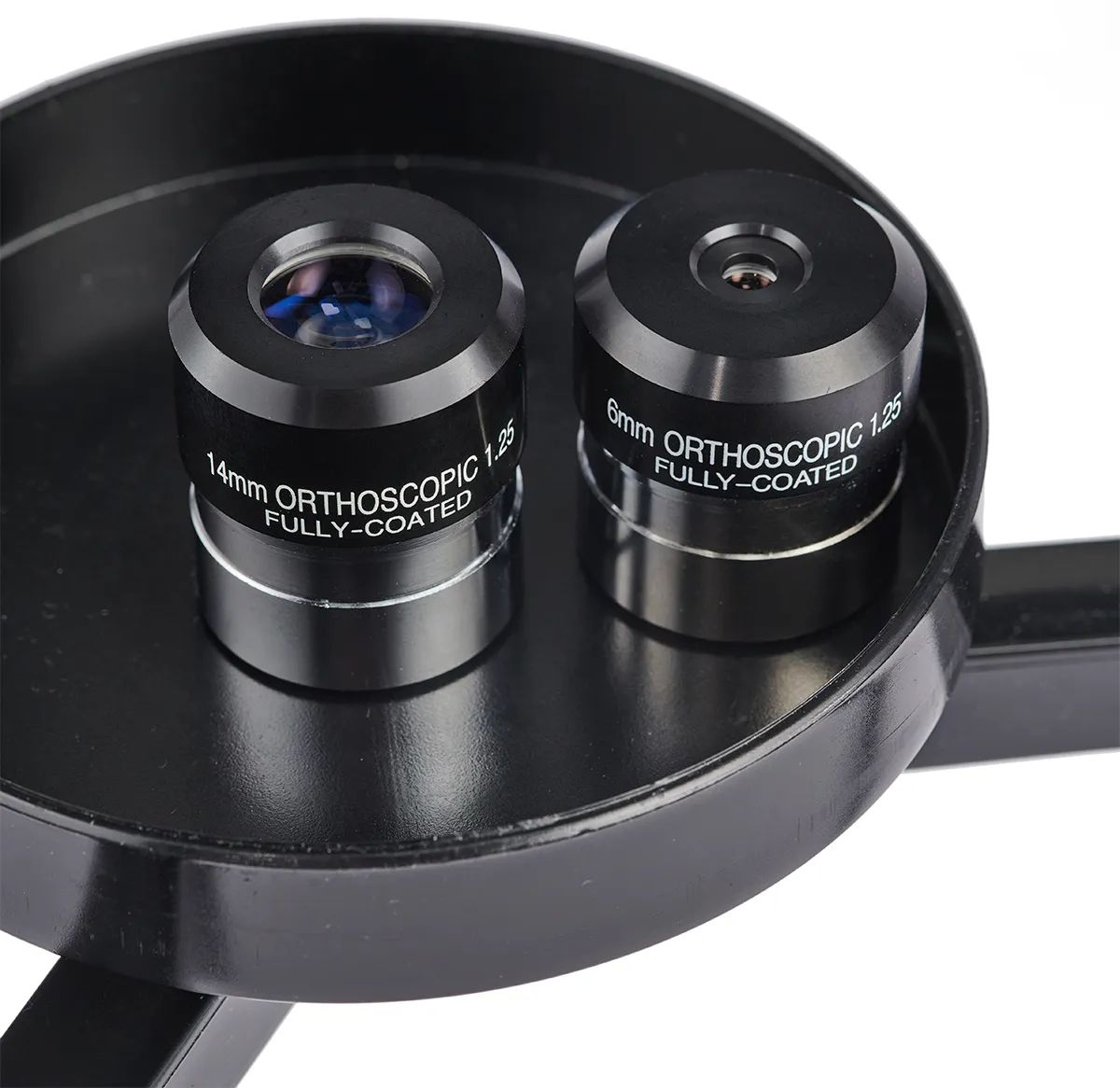The Starbase 80 refractor and mount package from First Light Optics is manufactured on behalf of Takahashi in Japan.
Although it is not actually made by Takahashi, the livery of the Starbase 80 is reminiscent of the pale green and white often associated with that company.
The aim is to provide an entry level, grab and go achromatic telescope on a portable easy-to-use altaz mount, which will complement the usual high-quality Takahashi optical systems we are used to seeing.
This telescope features in our list of the best telescopes for beginners and best telescopes for kids.

The assembly of the Starbase 80 system proved to be straightforward, with the mount and tripod in one section, so all we needed to do was to attach the tube and rings to it, before adding the slow-motion controls and altitude clamp.
Next, we added the star diagonal and an eyepiece and we were ready to go.
The objective lens, a fully magenta-coated achromat, is 80mm in diameter with a focal length of 800mm, which gives a focal ratio of f/10.
The mount is an altaz design with clamps for both axes and slow-motion controls.
We found it was very smooth in operation and the design also allowed us to view high-altitude targets, although it does put the eyepiece in a position that’s quite low down to reach.
There was little in the way of play on both axes so we could be confident that a target would stay in the field of view when we fine-tuned its position in the eyepiece.

Normally, we would expect to see a finderscope in a basic package like this, but the Starbase 80 employs a peep hole finder system.
Imagine two small right-angle pieces of Meccano attached to the optical tube: you line them up and look through them.
This works well for bright stars, but it’s a little harder when you are trying to hone in on deep-sky targets.
Two Orthoscopic 1.25-inch eyepieces are supplied in the standard package along with a star diagonal.
Interestingly, these eyepieces are not the regular 25mm and 10mm types that basic systems are often supplied with.
Instead, we have 14mm and 6mm eyepieces, which give magnifications of 57x and 133x respectively.
Although this did seem an odd combination, they worked quite well in use, allowing us to view a wide range of deep-sky targets and the Moon.
Unfortunately, the planets were located in poor positions during our tests and couldn’t be viewed.

When we set out to test the supplied Starbase 80 system we found a good range of adjustment in
the tripod.
This is helpful for observing mid-altitude targets, as you can position the eyepiece in a more comfortable position when using a seat.
Not only were we able to find the brightest deep-sky targets like the Orion Nebula, M42, and the Pleiades, M45, but we were able to locate the hazy central bulge of the Andromeda Galaxy and several bright double stars too.
With the 14mm eyepiece, we found that the Pleiades star cluster more than filled the view, while the Orion Nebula was enjoyable, with a good deal of visible nebulosity along with the four bright Trapezium Cluster stars at the centre.
Just south of the Orion Nebula is the double star Iota (ι) Orionis, which was nicely split, so we moved up to try Sigma (ς) Orionis and we could see the main three stars and the fainter fourth with averted vision.

Upping the magnification with the 6mm eyepiece, we could split Castor (Alpha (α) Geminorum) in the constellation of Gemini, the Twins, and Algieba (Gamma (γ) Leonis) in Leo, the Lion.
We noticed a faint reddish halo, which is often the case with achromatic systems because they don’t quite bring all the spectrum to a focus point, but it wasn’t too distracting.
Next, we turned our attention to the Moon, which was crisp in both the 14mm and 6mm eyepieces.
We were very pleased to discover that these revealed lots of detail, in and around the craters that were close to the terminator, which will no doubt provide plenty of hours of viewing pleasure.
There are optional extras, such as the Starbase 6x30 finderscope and 20mm and 9mm eyepieces, which we were loaned for the review.

Adding the 6x30 finderscope boosted our success in finding fainter targets such as the spiral galaxy NGC 2903 in the constellation Leo, the Lion, and the open star cluster M41 (sometimes known as the Little Beehive Cluster) in Canis Major, the Greater Dog.
The 20mm eyepiece allowed us to fit all the Pleiades, M45, in the field of view, which was very satisfying.
Meanwhile, the 9mm eyepiece gave us a crisper view of our selected double stars, without pushing the magnification too far, so again we would consider adding these as upgrades to the system.
Overall, this grab and go Starbase 80 system will provide an excellent entry-level opportunity for amateur astronomers, with a good variety of targets on view.
Starbase 80's altaz mount

One of the weak points in cheap, basic telescope packages is often the mount, which can prove to be sloppy and quite loose in operation, but this isn’t the case with the Starbase 80.
Plenty of thought has gone into making this altaz mount one that is rigid and sturdy, which provides good support to the telescope.
The altitude clamp allows enough friction to move the telescope up and down smoothly before locking into place, so you can fine-tune the altitude with the slow-motion control. There is also a useful altitude scale on one side to help you aim the telescope.
Similarly, the azimuth clamp works just as well, allowing a full 360° rotation before clamping, then fine tuning with its slow-motion control.
However, we would like to have seen an azimuth scale on this axis.
The design of the mount also ensures that any targets that are high in altitude can be reached without the telescope striking one of the tripod legs.
However, it does place the eyepiece at a very low position, so plan your targets carefully.

Starbase 80's 5 best features
Tripod
The steel tripod is lightweight, yet sturdy enough to support the mount and telescope. It has adjustable legs to make the viewing height more comfortable, and it has a simple but useful plastic accessories tray that also helps to spread the tripod legs and keep them in position.
Optics
The 80mm (3.2-inch) objective lens is a fully magenta coated achromatic to help improve contrast. It has a focal length of 800mm, which gives the system a focal ratio of f/10. The tube is lightweight and fitted with pale green tube rings for attaching to the mount.
Focuser
The focuser is a standard rack and pinion style that takes 1.25-inch eyepieces. It has a screw to clamp it in place when focused to prevent slippage, and we found it smooth in operation with hardly any play when focusing.
Accessories
The supplied Starbase 14mm and 6mm Orthoscopic eyepieces, with 57x and 133x magnifications, provided us with good views of our selected targets. The star diagonal uses a prism and allows you to look into the telescope at right angles instead of having to strain your neck by looking up through the tube.
Peep hole finder
The finder is unusual in that it is a peep hole-style system with two holes that you line up and look through. It works reasonably well for bright stars if you have good eyesight, but can be a little awkward if you are aiming the telescope high into the sky.
Vital stats
- Price £605
- Optics 80mm
- Focal length 800mm (f/10) focal length
- Mount Altaz mount with adjustable steel tripod
- Focuser Rack and pinion
- Extras Peep hole finder, 6mm & 14mm 1.25 inch-fit eyepieces, smooth slow-motion control cables, star diagonal and accessories tray
- Weight 6kg
- Supplier First Light Optics
- www.firstlightoptics.com
This review originally appeared in the May 2022 issue of BBC Sky at Night Magazine.
